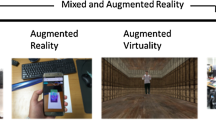Abstract
The popularization of virtual experience spaces involves several difficulties, and this paper focuses on part of them—additional equipment removal and cumbersome initialization process lightening. In this paper, a new automated initialization method to replace the traditional initialization process is proposed using the Kinect sensor, an affordable three-dimensional video capture device. Although the accuracy of this method is lower than that of other methods owing to the limitations of the Kinect sensor, it shows comparable performance under certain assumptions and offers users the opportunity to experience virtual space in a simple, low-cost manner.







Similar content being viewed by others
References
Cruz-Neira C, Sandin DJ, DeFanti TA, Kenyon RV, Hart JC (1992) The CAVE: audio visual experience automatic virtual environment. Commun ACM 35(6):64–72. doi:10.1145/129888.129892
Hartley R, Zisserman A (2004) Multiple view geometry in computer vision, 2nd edn. Cambridge University Press, March, pp. 65–72
Herrera CD, Kannala J, Heikkilä J (2012) Joint depth and color camera calibration with distortion correction. IEEE Trans Pattern Anal Mach Intell 34(10):2058–2064
Khoshelham K (2010) Automated localization of a laser scanner in indoor environments using planar objects. IEEE Int Conf Indoor Positioning Indoor Navig, pp. 1–7. doi:10.1109/IPIN.2010.5647576
Khoshelham K (2011) Accuracy analysis of kinect depth data. ISPRS Workshop Laser Scanning 38(5):W12
Lee S, Ko J, Kang S, Lee J (2010) An immersive elearning system providing virtual experience. IEEE Int Symp Mixed Augmented Real, pp. 249–250
Scaramuzza D, Harati A, Siegwart R (2007) Extrinsic self calibration of a camera and a 3D laser range finder from natural scenes. Int Conf Intell Robots Syst, pp. 4164–4169
Tsai RY (1987) A versatile camera calibration technique for high-accuracy 3D machine vision metrology using off-the-shelf TV cameras and lenses. IEEE J Robot Autom 3(4):323–344
Zhang Z (2000) A flexible new technique for camera calibration. IEEE Trans Pattern Anal Mach Intell 22(11):1330–1334
Zhang C, Zhang Z (2011) Calibration between depth and color sensors for commodity depth cameras. IEEE Int Conf Multimed Expo, pp. 1–6
Acknowledgments
This work was supported by the IT R&D program of MKE & KEIT [10041610, The development of the recognition technology for user identity, behavior and location that has a performance approaching recognition rates of 99 % on 30 people by using perception sensor network in the real environment]. This research was supported by the KUSTAR-KAIST Institute, Korea, under the R&D program supervised by the KAIST.
Author information
Authors and Affiliations
Corresponding author
Rights and permissions
About this article
Cite this article
Soh, J., Han, B., Choi, Y. et al. Automatic registration of a virtual experience space with Kinect. Multimed Tools Appl 74, 211–226 (2015). https://doi.org/10.1007/s11042-013-1757-5
Published:
Issue Date:
DOI: https://doi.org/10.1007/s11042-013-1757-5




